
The Lord of the Rings is an epic high-fantasy novel written by English author and scholar J. R. R. Tolkien. The story began as a sequel to Tolkien's 1937 fantasy novel The Hobbit, but eventually developed into a much larger work. Written in stages between 1937 and 1949, The Lord of the Rings is one of the best-selling novels ever written, with over 150 million copies sold.

The Hobbit, or There and Back Again is a children's fantasy novel by English author J. R. R. Tolkien. It was published on 21 September 1937 to wide critical acclaim, being nominated for the Carnegie Medal and awarded a prize from the New York Herald Tribune for best juvenile fiction. The book remains popular and is recognized as a classic in children's literature.
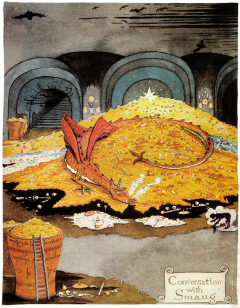
Smaug is a dragon and the main antagonist in J. R. R. Tolkien's 1937 novel The Hobbit, his treasure and the mountain he lives in being the goal of the quest. Powerful and fearsome, he invaded the Dwarf kingdom of Erebor 150 years prior to the events described in the novel. A group of thirteen dwarves mounted a quest to take the kingdom back, aided by the wizard Gandalf and the hobbit Bilbo Baggins. In The Hobbit, Thorin describes Smaug as "a most specially greedy, strong and wicked worm".
In the fantasy of J. R. R. Tolkien, the Dwarves are a race inhabiting Middle-earth, the central continent of Earth in an imagined mythological past. They are based on the dwarfs of Germanic myths: small humanoids that dwell in mountains, and are associated with mining, metallurgy, blacksmithing and jewellery.
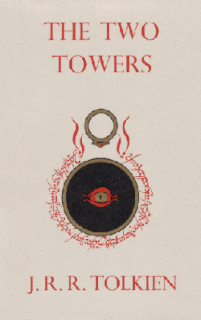
The Two Towers is the second volume of J. R. R. Tolkien's high fantasy novel The Lord of the Rings. It is preceded by The Fellowship of the Ring and followed by The Return of the King.
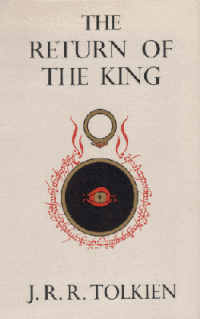
The Return of the King is the third and final volume of J. R. R. Tolkien's The Lord of the Rings, following The Fellowship of the Ring and The Two Towers. The story begins in the kingdom of Gondor, which is soon to be attacked by the Dark Lord Sauron.
This list contains only complete, printed English-language editions of The Hobbit by J. R. R. Tolkien. It is not for derived or unprinted works such as screenplays, graphic novels, or audio books.

Pauline Diana Baynes was an English illustrator, author and commercial artist. She contributed drawings and paintings to more than two hundred books, mostly in the children's genre. She was the first illustrator of some of J. R. R. Tolkien's minor works and of C. S. Lewis's Chronicles of Narnia.

Bilbo's Last Song is a poem by J. R. R. Tolkien that is a pendant to his fantasy The Lord of the Rings. It was first published in a Dutch translation in 1973, subsequently appearing in English on posters in 1974 and as a picture-book in 1990. It was illustrated by Pauline Baynes, and set to music by Donald Swann and Stephen Oliver. The poem's copyright was owned by Tolkien's secretary, to whom he gave it in gratitude for her work for him.
The Red Book of Westmarch is a fictional manuscript written by hobbits, a conceit of author J. R. R. Tolkien to explain the source of his fantasy writings.
In J. R. R. Tolkien’s fictional universe of Middle-earth, the Old Forest was a daunting and ancient woodland just beyond the eastern borders of the Shire. Its first and main appearance in print was in The Fellowship of the Ring, especially in chapter VI, which is titled "The Old Forest".
Magic, as referred in this article, pertains to mystical, paranormal, or supernatural activity as it appears in J. R. R. Tolkien's fictional realm of Eä, of which Middle-earth is a part. In an unsent draft of a letter in 1954, Tolkien argues that magia and goeteia are both used for good and bad purposes, but neither are inherently good or bad in itself.
Tolkien's legendarium is the body of J. R. R. Tolkien's mythopoeic writing that forms the background to his The Lord of the Rings, a high fantasy novel which is widely considered to be his magnum opus.
Elrond Half-elven is a fictional character in J. R. R. Tolkien's Middle-earth legendarium. He is introduced in The Hobbit, and plays a supporting role in The Lord of the Rings and The Silmarillion.
In the fiction of J. R. R. Tolkien, Moria, also named Khazad-dûm, is an ancient subterranean complex in Middle-earth, comprising a vast labyrinthine network of tunnels, chambers, mines and halls under the Misty Mountains, with doors on both the western and the eastern sides of the mountain range. Moria is introduced in Tolkien's novel The Hobbit, and is a major scene of action in The Lord of the Rings.
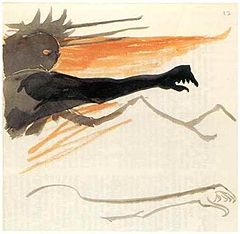
Sauron is the title character and the main antagonist of J. R. R. Tolkien's The Lord of the Rings, where he rules the land of Mordor and has the ambition of ruling the whole of Middle-earth.

The Road to Middle-Earth: How J. R. R. Tolkien Created a New Mythology is a scholarly study of the works of J. R. R. Tolkien written by Tom Shippey. In Great Britain it was first published by Allen & Unwin in 1982, with a second edition published in 1993 by Harper Collins and a revised and expanded third edition published in 2003. It is currently published by Houghton Mifflin in the United States.

The Fellowship of the Ring is the first of three volumes of the epic novel The Lord of the Rings by the English author J. R. R. Tolkien. It is followed by The Two Towers and The Return of the King. It takes place in the fictional universe of Middle-earth. It was originally published on 29 July 1954 in the United Kingdom.
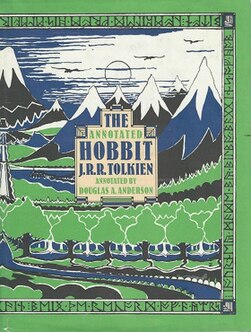
The Annotated Hobbit: The Hobbit, or There and Back Again is an edition of J. R. R. Tolkien's novel The Hobbit with a commentary by Douglas A. Anderson. It was first published in 1988 by Houghton Mifflin Harcourt, Boston, in celebration of the 50th anniversary of the first American publication of The Hobbit, and by Unwin Hyman of London.














